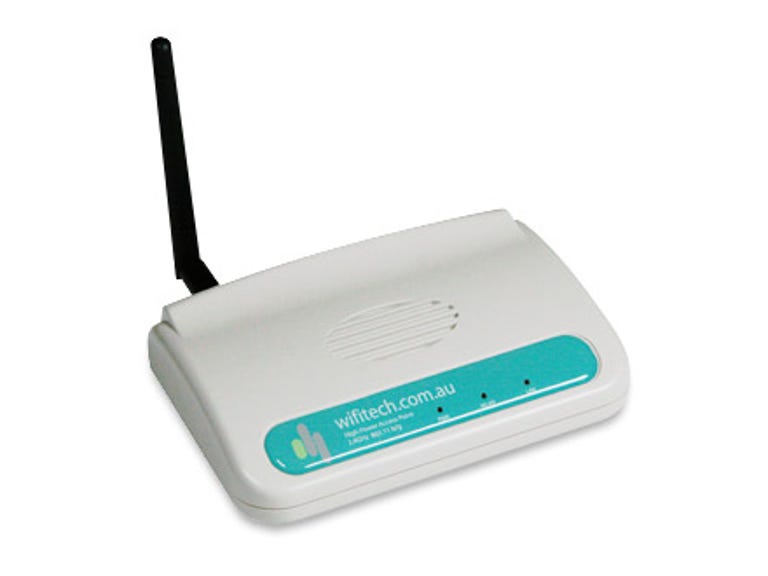 Why You Can Trust CNET
Why You Can Trust CNET WiFi-Tech WTAP2400 review: WiFi-Tech WTAP2400
The WTAP2400 works well enough as a basic wireless access point -- with an accent on the basic.
Design
The WTAP2400 is an 802.11b/g access point with a rather plain design. If you've been around PC networking gear for a while, you may find (as we did) that it's somewhat reminiscent of the designs that Banksia used to use for their 56k modems; lots of beige plastic broken up with a main aqua display panel. It's not a horrible design, and it does have the benefit of being remarkably small -- 125x80x30mm -- and with its role as an access point in mind, it's also wall mountable. Plenty of access points and routers offer wall mountability, but most stick out badly thanks to their large size -- not the case for the WTAP2400.
The Good
The Bad
The Bottom Line
Visual controls and ports are at a minimum on the WTAP2400, with a single power, WLAN and LAN light on the front, and power, reset, 10/100 ethernet and a standard SMA antennae connector on the rear. WiFiTech also sell a variety of higher-power antennae, and these would be suitable for use on the WTAP2400.
Features:
It's important to note that the WTAP2400 is a wireless access point, not a wireless gateway -- you'll still need an interface between your broadband connection and the WTAP2400. Given the teeming mass of combination gateway/routers in the marketplace, it's fair to argue that the primary case for buying the WTAP2400 is as a range extension device for an existing wireless network, especially given the paucity of wired network ports on the device.
The WTAP2400 supports working in access point or station mode, and with the usual offerings for wireless security that we'd expect out of a modern wireless access point, including WEP, WPA RADIUS and WPA-PSK.
Logging into the admin panel through the default password of "1234", the WTAP2400's configuration page can only be described as basic, with a weird mix of styles at play. The basic controls wouldn't look out of place on a Windows NT workstation, but the Apply and Cancel buttons look like they've been bitmap-ripped straight out of an earlier version of Mac OS X. The effect is, to put it politely, weird.
Performance
Once the WTAP2400 was set up, it worked almost exactly as you'd expect an 802.11b/g access point to work. Comparing it side by side with an existing 802.11n Linksys WRT160N we had set up already, it understandably performed worse in close and medium range throughput tests, as you'd expect. Using it as a range extender worked considerably better, and given its somewhat basic presentation that's the role we'd suggest it works best in.
One minor factor that did concern us was that for whatever reason, the power light has a tendency to flicker independent of LAN or wireless activity. It didn't seem to power up or down during these times, just flicker. If you've ever worried that networking gear was watching you, this may not be the AP to buy.
Actually, ultimately this probably isn't the AP to buy anyway. At AU$100 it's a touch overpriced in the current market, especially given that it's an 802.11b/g product only, and the market is finally making that last gasp lunge towards 802.11n that we've all been waiting on for the past few years. At AU$100, the WTAP2400 is expensive, considering that low cost gateways such as D-Link's DIR-300 retail for a dollar less, and even emerging N routers such as Linksys' WRT160N aren't that much more expensive.



